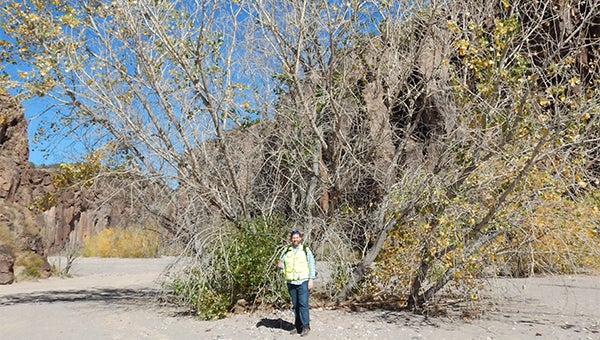ERDC researcher leading team modeling post-wildfire floods
Published 11:09 pm Friday, November 3, 2017

- Ian Floyd stands near a mature cotton wood tree in Oct. 2016 with approximately 10 – 12 feet of sediment discovered following a post-wildfire debris flow near Cochiti Lake, NM.
Now that the recent wildfires in California and Oregon that burned through more than a million acres have been extinguished, the work is just beginning for Ian Floyd and his team of researchers at the U.S. Army Engineer Research and Development Center in Vicksburg.
Floyd is a Research Physical Scientist with a background in Geology. He and his team are working to improve the U.S. Army Corps of Engineers’ model for predicting post-wildfire floods.
They have been working to develop the model since 2011 following a wildfire in New Mexico that posed a major threat to the reservoir that serves as the main supply of drinking water for Albuquerque.
“In these post wildfire environments all the vegetation is gone and you make the soil hydrophobic so it doesn’t like water, it repels it,” Floyd said. “When you have a rainfall whereas in the past you have had a little sediment and water, you actually get a ton of sediment and water. You add more sediment to the flow and that causes a lot of problems.”
The Corps of Engineers has a model that can track typical sediment flow in a current of water, Floyd said, but in a post-wildfire environment they can see upwards to 1,000 times the amount of sediment in the water, which can cause devastating impacts as it flows and after the water has receded.
“A good examples of these increases in sediment and the effects we see can be described by thinking about adding additional mass,” Floyd said. “If you have a train that you put wheels on and you have a car and you rolled them down the same slope, as it moves down the slope, the train is going to go faster and faster and actually travel further than the car would because it has added mass.”
The flow of water will also leave all the additional sediment behind, which can cause flooding in areas that typically would have been safe from rising water.
“If you take a bathtub and fill it with a certain amount of water and you take that water out, you put a certain amount of sediment in the bottom and you put that water back in, you can’t put the same amount of water back into it,” Floyd said. “This is what happens in these wildfire. Quite literally all the sediment from the mountain is eroded off and that goes into the floodplain.”
With the amount of extra sediment in the water, Floyd said, it begins to act more like honey than water. It has the ability to pick up and carry a large boulder that can cause further damage as the water begins to gain steam as it flows.
“The best way to think of it is if you have a column of water and a column of honey and you drop steel BBs, the BBs are going to settle way slower in the honey,” Floyd said. “That is the same effect with these big boulders. The problem is these boulders can hit a road and completely destroy it because they are moving really fast.”
With the more than a million acres that recently burned in California and Oregon posing a threat, Floyd and his team will be traveling to the sites of the fires to help predict that possible impact caused by post-wildfire floods and help the Corps of Engineers work to mitigate some of the impact.
“One of the things we are trying to do there other than better predict this is maximize our mitigation if we are going to build or do something to offset all that,” Floyd said. “A lot of time what is beneficial in the watersheds is building big holes or basins so it can fill back in. We are looking at the modeling, but also linking the modeling to the management of the impact.”
They hike through the watershed, take photos and survey the slopes as they work to predict which areas have the highest probability of eroding and causing possibly detrimental flooding.
“The problem is, post-wildfire flooding is so extreme, these sedimentation events are very nonlinear and complex that we can’t predict them with Corps models,” Floyd said. “What I’m trying to do is develop and add in the physics to describe the honey versus the water.”





